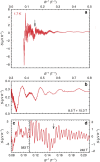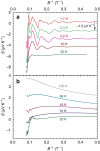Thermoelectric quantum oscillations in ZrSiS
- PMID: 28537261
- PMCID: PMC5529674
- DOI: 10.1038/ncomms15219
Thermoelectric quantum oscillations in ZrSiS
Abstract
Topological semimetals are systems in which conduction and valence bands cross each other and the crossings are protected by topological constraints. These materials provide intriguing tests for fundamental theories, while their unique physical properties promise a wide range of possible applications in low-power spintronics, optoelectronics, quantum computing and green energy harvesting. Here we report our study of the thermoelectric power of single-crystalline ZrSiS that is believed to be a topological nodal-line semimetal. We show that the thermoelectric power is an extremely sensitive probe of multiple quantum oscillations that are visible in ZrSiS at temperatures as high as 100 K. Two of these oscillations are shown to arise from three- and two-dimensional electronic bands, each with linear dispersion and the additional Berry phase predicted theoretically for materials with non-trivial topology. Our work not only provides further information on ZrSiS but also suggests a different route for studying other topological semimetals.
Conflict of interest statement
The authors declare no competing financial interests.
Figures







References
-
- Fang C., Chen Y., Kee H.-Y. & Fu L. Topological nodal line semimetals with and without spin-orbital coupling. Phys. Rev. B 92, 081201 (2015).
-
- Wu Y. et al.. Dirac node arcs in PtSn4. Nat. Phys. 12, 667–671 (2016).
-
- Neupane M. et al.. Observation of topological nodal fermion semimetal phase in ZrSiS. Phys. Rev. B 93, 201104 (2016).
LinkOut - more resources
Full Text Sources
Other Literature Sources

